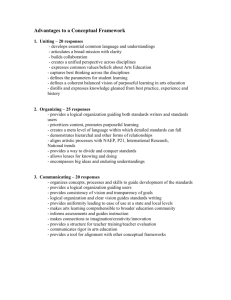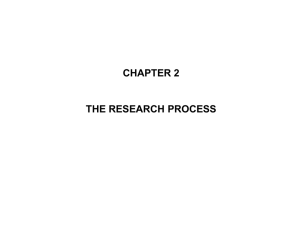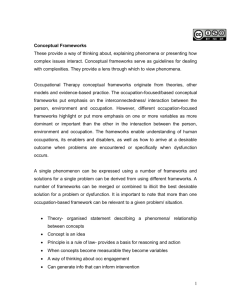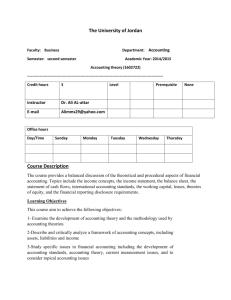Conceptual Framework
advertisement
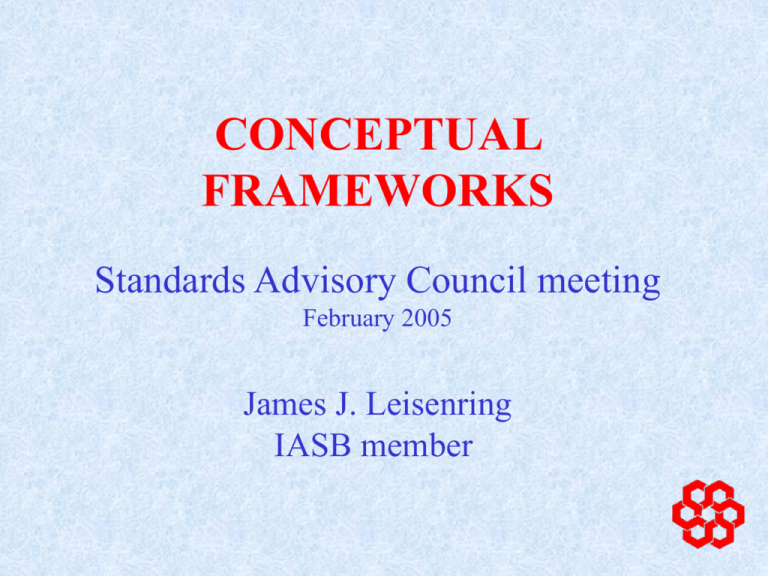
CONCEPTUAL FRAMEWORKS Standards Advisory Council meeting February 2005 James J. Leisenring IASB member CONCEPTUAL FRAMEWORKS • In the areas I want to discuss, there are only small differences between the IASB and FASB framework • Focus on the elements of financial statements and on recognition and not measurement as both frameworks are quite unresolved as to measurement • FASB Conceptual Framework more expansive and I have selected it to describe several points also made in IASB Framework CONCEPTUAL FRAMEWORKS • Purposes of the two frameworks are quite similar • Both frameworks accept decision usefulness of information to a broad group of outsiders as the purpose of financial reporting (IAS paragraph 12) • More expansive use of IASB framework as a result of IAS 8 hierarchy for establishing accounting policies CONCEPTUAL FRAMEWORKS The FASB in Concepts Statement No. 1 concluded: “. . . Financial reporting should provide information to help investors, creditors, and others assess the amount, timing, and uncertainty of prospective net cash inflows to the related enterprise.” (paragraph 39) The IASB framework: “The economic decisions that are taken by users of financial statements require an evaluation of the ability of an entity to generate cash and cash equivalents and of the timing and certainty of their generation.” (paragraph 15) CONCEPTUAL FRAMEWORKS “The primary focus of financial reporting is information about an enterprise’s performance provided by measures of earnings and its components. Investors, creditors, and others who are concerned with assessing the prospects for enterprise net cash inflows are especially interested in that information.” (Con 1, paragraph 43) CONCEPTUAL FRAMEWORKS Furthermore, the Board said, “Information about enterprise earnings and its components measured by accrual accounting generally provides a better indication of enterprise performance than information about current cash receipts and payments.” (Con 1, paragraph 44) CONCEPTUAL FRAMEWORKS “Financial statements prepared on the accrual basis inform users not only of past transactions involving the payment and receipt of cash but also of obligations to pay cash in the future and of resources that represent cash to be received in the future. Hence, they provide the type of information about past transactions and other events that is most useful to users in making economic decisions.” (IAS, paragraph 22) CONCEPTUAL FRAMEWORKS “Information about the performance of an entity, in particular its profitability, is required in order to assess potential changes in the economic resources that it is likely to control in the future. Information about variability of performance is important in this respect. Information about performance is useful in predicting the capacity of the entity to generate cash flows from its existing resource base.” (IAS, paragraph 17) CONCEPTUAL FRAMEWORKS • Accepting these conclusions focuses the debate on the items to be recognized in accrual basis earnings (profit and loss) and the measurement of those items. • The fundamental nature of most accounting debates is that we don’t agree on what should be considered earnings or profit and loss. CONCEPTUAL FRAMEWORKS • Controversy sometimes over amount • Controversy usually over timing and uncontrolled volatility • Controversy over classification and display of items in earnings or profit and loss CONCEPTUAL FRAMEWORKS Source of the Early Debates • Assets, liabilities, or “what-you-may-call-its” • Proper matching to avoid “distorting” periodic income • Argument often used to avoid recognition of an item is that the result will “distort” income (earnings) CONCEPTUAL FRAMEWORKS APB STATEMENT NO. 4—ASSETS • Assets—economic resources of an enterprise that are recognized and measured in conformity with generally accepted accounting principles. Assets also include certain deferred charges that are not resources but that are recognized and measured in conformity with generally accepted accounting principles. CONCEPTUAL FRAMEWORKS APB STATEMENT NO. 4—LIABILITIES • Liabilities—economic obligations of an enterprise that are recognized and measured in conformity with generally accepted accounting principles. Liabilities also include certain deferred credits that are not obligations but that are recognized and measured in conformity with generally accepted accounting principles. CONCEPTUAL FRAMEWORKS Asset “Assets are probable future economic benefits obtained or controlled by a particular entity as a result of past transactions or events.” (Con 6, paragraph 25) CONCEPTUAL FRAMEWORKS Liability “Liabilities are probable future sacrifices of economic benefits arising from present obligations of a particular entity to transfer assets or provide services to other entities in the future as a result of past transactions or events.” (Con 6, paragraph 35) CONCEPTUAL FRAMEWORKS Asset “An asset is a resource controlled by the entity as a result of past events and from which future economic benefits are expected to flow to the entity.” (IAS, paragraph 49a) CONCEPTUAL FRAMEWORKS Liability “A liability is a present obligation of the entity arising from past events, the settlement of which is expected to result in an outflow from the entity of resources embodying economic benefits.” (IAS, paragraph 49b) CONCEPTUAL FRAMEWORKS Assets Three essential characteristics: (Con 6, paragraph 26) “(a) It embodies a probable future benefit that involves a capacity, singly or in combination with other assets, to contribute directly or indirectly to future net cash inflows (b) A particular entity can obtain the benefit and control others’ access to it (c) The transaction or other event giving rise to the entity’s right to or control of the benefit has already occurred.” CONCEPTUAL FRAMEWORKS Liabilities Three essential characteristics: (Con 6, paragraph 36) “(a) It embodies a present duty or responsibility to one or more other entities that entails settlement by probable future transfer or use of assets at a specified or determinable date, on occurrence of a specified event, or on demand (b) The duty or responsibility obligates a particular entity, leaving it little or no discretion to avoid the future sacrifice (c) The transaction or other event obligating the has already happened.” CONCEPTUAL FRAMEWORKS Revenues “Revenues are inflows or other enhancements of assets of an entity or settlements of its liabilities (or a combination of both) from delivering or producing goods, rendering services, or other activities that constitute the entity’s ongoing major or central operations.” (Con 6, paragraph 78) CONCEPTUAL FRAMEWORKS Expenses “Expenses are outflows or other using up of assets or incurrences of liabilities (or a combination of both) from delivering or producing goods, rendering services, or carrying out other activities that constitute the entity’s ongoing major or central operations.” (Con 6, paragraph 80) CONCEPTUAL FRAMEWORKS Income “Income is increases in economic benefits during the accounting period in the form of inflows or enhancements of assets or decreases of liabilities that result in increases in equity, other than those relating to contributions from equity participants.” (IAS, paragraph 70a) CONCEPTUAL FRAMEWORKS Expenses “Expenses are decreases in economic benefits during the accounting period in the form of outflows or depletions of assets or incurrences of liabilities that result in decreases in equity, other than those relating to distributions to equity participants.” (IAS, paragraph 70b) CONCEPTUAL FRAMEWORKS IASB and FASB Framework • Basic conclusion as to the conceptual primacy of assets and secondarily liabilities • Thought to be a “balance sheet” approach • Can there be an “income statement” view? CONCEPTUAL FRAMEWORKS “To me, the definitions were the missing boundaries that were needed to bring the accrual accounting system back under control. The definitions have, I hope, driven a stake part way through the “nondistortion” guideline. But I am realistic enough to know, having dealt with the subjects of foreign currency translation and pension cost measurement, that the aversion to volatility in earnings is so strong that the notion of “nondistortion” will not die easily.” (Donald Kirk) CONCEPTUAL FRAMEWORKS “Some individual frameworks are sharply defined and firmly held; others are vague and weakly held; still others are vague and firmly held.” (Chuck Horngren—Stanford University) CONCEPTUAL FRAMEWORKS “Accounting is more a process of allocating transactions to accounting periods by reference to the established conventions of matching and prudence. . . . Assets and liabilities do not form a natural starting point for devising recognition rules; the balance sheet is the result of the accounting process, not the starting point.” (Ron Paterson—Ernst & Young—UK) CONCEPTUAL FRAMEWORKS “Paterson’s ‘balance sheet [that] is the result of the accounting process’ is commonly the result of debits and credits that have been created as the necessary offsetting entries to achieve the ‘appropriate’ amount of revenue and expense. Many of those debits and credits do not meet the definitions of assets or liabilities but nevertheless are identified as such on balance sheets. Would it be acceptable to Paterson to accurately describe those items as ‘debit (or credit) necessary to get net income to the “appropriate” level’? I doubt it.” (James J. Leisenring—FASB—USA) CONCEPTUAL FRAMEWORKS IASB Framework “. . .The application of the matching concept under this Framework does not allow the recognition of items in the balance sheet which do not meet the definition of assets or liabilities.” (IAS, paragraph 95) CONCEPTUAL FRAMEWORKS IASB Framework “Income is recognised in the income statement when an increase in future economic benefits related to an increase in an asset or a decrease of a liability has arisen that can be measured reliably.” (IAS, paragraph 92) CONCEPTUAL FRAMEWORKS IASB Framework “Expenses are recognised in the income statement when a decrease in future economic benefits related to a decrease in an asset or an increase of a liability has arisen that can be measured reliably.” (IAS, paragraph 94) CONCEPTUAL FRAMEWORKS For the income statement view to have any intellectual rigor, proponents must either: • Define revenue and expense without regard to assets and liabilities. • Accept that a balance sheet will contain a debit or credit necessary to achieve the “appropriate” amount of net income. • Define or describe what is the “appropriate” amount of net income CONCEPTUAL FRAMEWORKS • Can’t define revenues, expenses, gains, and losses without reference to assets • Absent independent definition of revenues, expenses, gains, and losses (not dependent on assets and liabilities), the income statement view is vacuous • Measuring net income by the change in net assets provides an anchor for resolving difficult accounting questions CONCEPTUAL FRAMEWORKS Asking the Right Questions What is the asset? What is the liability? Did an asset or liability or its value change? Increase or decrease? By how much? Did the change result from what we call: Investment by owners? Distribution to owners? Comprehensive income? Revenue? Expense? Gain? Loss? (Storey & Storey) CONCEPTUAL FRAMEWORKS Standards Advisory Council meeting February 2005 James J. Leisenring IASB member
